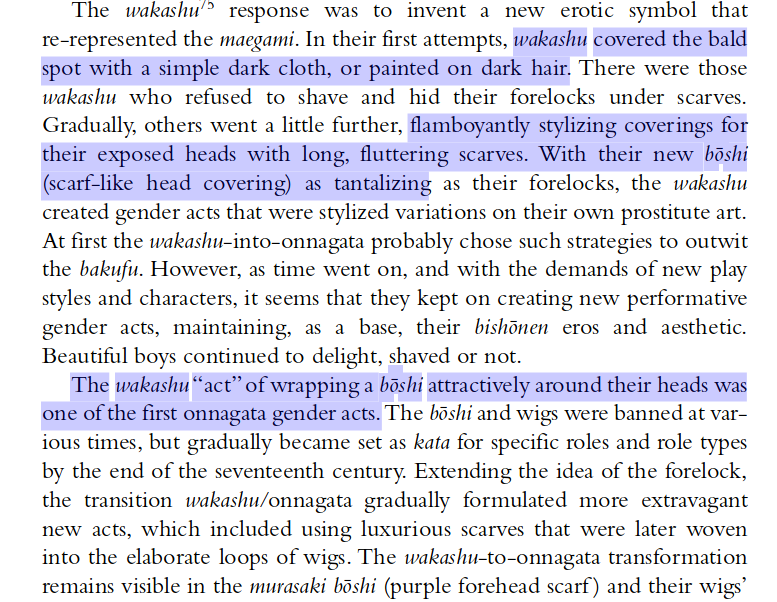Trans Women& #39;s Hair Cultures: Notes on Public Trauma, Hair, & History
This is a variety of observations on the relationship trans women have had to our hair throughout history & how that& #39;s changed our relations with each other. Maybe for a longer piece. Share if you like it! https://abs.twimg.com/emoji/v2/... draggable="false" alt="💇" title="Haircut" aria-label="Emoji: Haircut">
https://abs.twimg.com/emoji/v2/... draggable="false" alt="💇" title="Haircut" aria-label="Emoji: Haircut">
This is a variety of observations on the relationship trans women have had to our hair throughout history & how that& #39;s changed our relations with each other. Maybe for a longer piece. Share if you like it!
Observation #1: Trans women& #39;s relationship to our hair is initially traumatic.
Ex. 1a: The recent Luna Younger case. Also, this related thread from @transscribe, which is why I& #39;m putting together these notes.
https://twitter.com/transscribe/status/1194263455479586816">https://twitter.com/transscri...
Ex. 1a: The recent Luna Younger case. Also, this related thread from @transscribe, which is why I& #39;m putting together these notes.
https://twitter.com/transscribe/status/1194263455479586816">https://twitter.com/transscri...
Ex. 1b: Japan 1652. *Ayamegusa* states many *onnagata*, or "female-likenesses" in Japanese theater, transform their bodies & persist in their performance in daily life.
*Onnagata* (and *wakashu*, *wakaonnagata*) were ordered by Shogunate sumptuary laws to shave their heads.
*Onnagata* (and *wakashu*, *wakaonnagata*) were ordered by Shogunate sumptuary laws to shave their heads.
Ex 1c: c. 10 AD. Gallae, transfemme religious figures in the Phrygian cult of the Great Mother, grew their hair long. This was a regular source of mockery from Romans, who both bullied & had sex with them. Such rhetoric of bullying is recorded in the Aeneid - "befoul his hair."
Observation #2: Trans women form reparative communities in response to public traumatization. Trauma is productive: of culture, identity, care, love.
Sidebar: Trans women gather to heal from trauma. This is historically distinct from gay gatherings, which were usually for sex.
Sidebar: Trans women gather to heal from trauma. This is historically distinct from gay gatherings, which were usually for sex.
Ex 2a: *Onnagata* again. Responses to forced head shaving included hiding one another from police, and generating a novel beauty/hair culture. Necessity is the (trans) mother of invention.
Ex 2b: New York c. 2010. Bryn Kelly gives trans girls new to the big city (running away from home, etc) their first "New York cut." Pop-up at-home hairdressers like this are common among trans culture. We are overcharged elsewhere and often give one another discounts.
Ex 2c: Argentina 1900. Trans women like Aurora are criminalized for engaging in society as women. Because of this activity, our businesses as "pop-up hairstylists" are frequently ghettoized to brothels.
Ex 2d: Washington D.C. 2013. The skill many of us have acquired as hairdressers, often from public traumatization, can sometimes break into a career. We try to pay this forward, most notably when trans woman Consuella Lopez hires trans woman Brandi Ahzionae.
Observation #3: Trans women will force-cut one another& #39;s hair as a way to return each other to shame.
Communities of reparation are communities of necessity, not desire. Trans friendships can be bitter because they can represent our alienation from cis (mainstream) society.
Communities of reparation are communities of necessity, not desire. Trans friendships can be bitter because they can represent our alienation from cis (mainstream) society.
Ex 3a: Brazil 1990. Early *travesti* communities had women who would cut one another& #39;s hair while sleeping, usually if one had stolen another& #39;s boyfriend.
Ex 3c (contra): Los Angeles 2015. The final scene of Sean Baker& #39;s incredible *Tangerine*. Sin-dee has urine thrown in her hair by transphobic men. Alexandra swaps wigs while the other is being washed. Sin-dee& #39;s look is jaundiced, taking the hand of the only human she knows cares.
Observation #4: Cis people don& #39;t understand any of this.
Cis people think about our hair and see a war against nature. Cis people naturalize the oppression they inflict upon us, in order to relieve themselves of moral responsibility.
Cis people think about our hair and see a war against nature. Cis people naturalize the oppression they inflict upon us, in order to relieve themselves of moral responsibility.
Sometimes this is obvious. When a transphobic Shogunate or abusive father force us to buzz, it is because we are too convincingly women. Cis people require masculinity to affirm maleness. They need gender for sex. This fact is a major reason the sex-gender distinction fails.
Don Kulick sees 1990s *travesti* shaming rituals as a way for trans women to return to an innate maleness. He sees it this way because he is a transphobic cis person naturalizing transgender oppression.
Trans women& #39;s shaming rituals are designed to retraumatize, not masculinize.
Trans women& #39;s shaming rituals are designed to retraumatize, not masculinize.
Sidebar: Trans women are almost never discussed in the context of trauma theory. Our victimhood in the AIDs crisis is passed over regularly...
...Queer trauma theorists and scholars mostly arise in lesbian communities. They instead fetishize and reterritorialize transmale trauma, especially the case of Brandon Teena (re Ann Cvetkovich, Carolyn Gage).
Conclusion: Part of trans liberation requires capitulating a certain t4t dimension of transgender life. Our hair culture is definitely one of them; as trans hairdressers gain notoriety, the tiny pop-up at-home t4t hairstylist goes the way of the dodo.

 Read on Twitter
Read on Twitter











